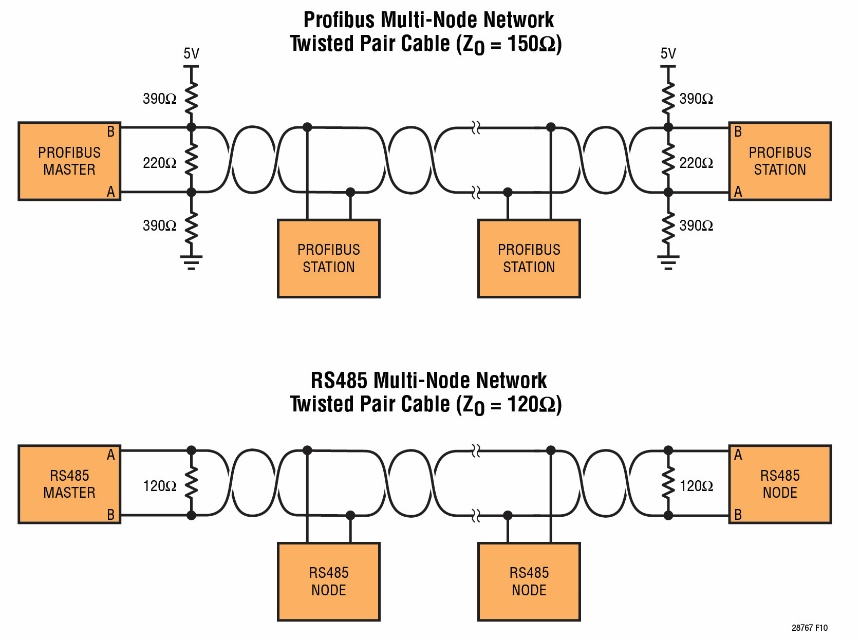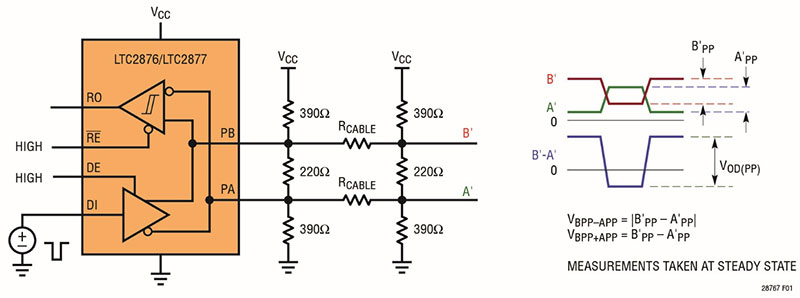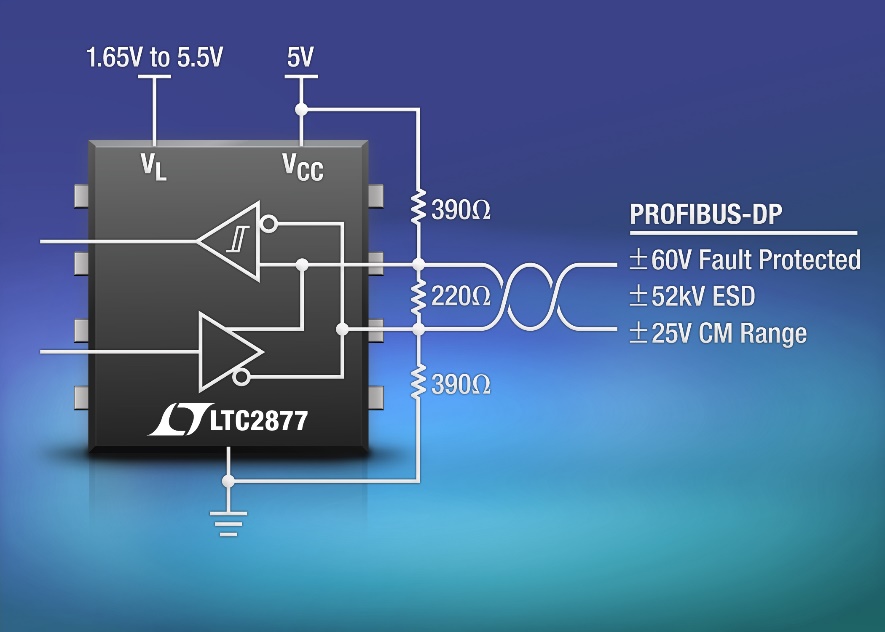Author: Christopher Gobok, Product Marketing Engineer, Mixed Signal Products, Linear Technology
introduction
PROFIBUS-DP (Distributed Peripherals) Fieldbus standards have existed for more than 20 years, however, the requirements of the physical layer may remain unclear, often leading to confusion in the transceiver definition. However, any ambiguity clearly does not prevent PROFIBUS from becoming a successful (and perhaps the most successful) fieldbus solution, with more than 50 million devices installed worldwide.
When deploying a new system, it is important to know that the transceivers used are designed with the latest and accurate interpretation of the PROFIBUS-DP standard. Linear Technology's LTC2877 PROFIBUS-DP receiver addresses this need by adopting the latest IEC 61158-2 PROFIBUS-DP standard and adding the ultimate retention mechanism to enhance new master devices and The compatibility and reliability of the controlled device.
PROFIBUS-DP basics
The faster and simpler PROFIBU-DP standard was born in 1993 based on the slower, more complex PROFIBUS FMS (Fieldbus Message Specification) parent standard. PROFIBU-DP also has a "younger brother" or derivative standard PROFIBUS-PA (Process Automation), which uses Manchester Code Bus Powered (MBP) transmission and adds bus-powered functionality, making it ideal for hazardous environments. Security application. In addition, PROFIBUS-DP is currently the most widely used version of PROFIBUS, probably because its plug-and-play basic features, flexibility and cost-effectiveness are attractive in most fieldbus applications. From the management of sensors and actuators in industrial plants to the communication with flow meters on railway stations, PROFIBUS-DP disperses I/O cards (masters) from controllers and brings them closer to sensors and actuators. Controller), which brings many benefits to installation and operation.
PROFIBUS-DP can communicate over a variety of media, including copper wire, fiber optics, and even air (in infrared communication devices). So far, the most commonly used bit transfer of PROFIBUS-DP masters and slaves (the first layer of the ISO/OSI model) media is twisted pair, which is connected to TIA/EIA-485-A (RS485). A device that communicates with a transceiver. This is not surprising given the high-speed differential signaling capabilities of RS485 and the ability to perform robust communications between multiple devices over long distances in noisy environments such as factory applications. In a linear topology, multiple masters using RS485 transceivers, such as PLCs (Programmable Logic Controllers), can connect 30 slaves per segment. In this topology, a hub (parallel segment) is used or The repeater (serial segment) expands the network to connect to 124 slaves. Each segment must be terminated at both ends with an active terminal. All slaves are hot swappable to the bus and their location is irrelevant because each slave is assigned a unique network address.
95% RS485, 5% mixed
PROFIBUS-DP uses most of the TIA/EIA-485-A (RS485) standards, but it does make a few changes that are accidentally ignored due to large system problems. Therefore, contrary to what is generally believed, not all RS485 transceivers and cables are suitable for PROFIBUS-DP networks and vice versa. Differences in cabling, termination, signal names, and drive requirements do exist; too rushing to consider these differences may easily allow you to pay for the performance of the master or controlled device (or worse, including authentication) cost.
Although the RS485 standard does not specify any special cabling requirements, 120Ω shielded twisted pair has become the usual recommended solution. However, PROFIBUS-DP recommends a 150Ω shielded twisted pair. Unfortunately, 120 Ω cannot be approximated to 150 Ω, and this small cable impedance difference actually leads to the need for different (and in most cases new) cables. In addition, PROFIBUS-DP also specifies a maximum cable length that depends on which of the 10 baud rate "steps" is used (from 1200m at 9.6kbps to 100m at 12Mbps).
Of course, the cable impedance requirements are different, and the terminal requirements will be different. To minimize signal reflection, RS485 devices typically use a single 120Ω termination resistor on both ends of the bus, while PROFIBUS-DP recommends a 171Ω termination network at both ends of the bus. Wait a minute, is this a typing error? ... PROFIBUS-DP recommends a 171 Ω termination network, so it does not match the 150 ohm cable characteristic impedance recommended by it. exactly! Figure 1 shows how the cable and terminal networks used in PROFIBUS-DP differ from RS485. As can be seen, PROFIBUS-DP uses two 390Ω bus bias resistors together with a 220Ω termination resistor; the effective differential resistance of the termination network is 171Ω, which is obviously not exactly matched with the 150Ω cable, thus forming a slight underdamped network of. But don't worry, because at the receiving end of the cable it presents itself as just a small bump (ie, increase) in the signal voltage, and the duration is twice the cable propagation delay.

Figure 1: Cable, terminal and pin differences in RS485 and PROFIBUS-DP networks
If the cable/terminal mismatch is not enough, the naming of the bus pins on the PROFIBUS transceiver should further ruin your expectations. You may have noticed the opposite pin names used in Figure 1. In most general-purpose RS485 transceivers, pin A is the in-phase receiver input (and the non-inverting driver output), while pin B is the inverting receiver input (and the inverting driver output), which is relative to the receiver output. And drive input. However, the PROFIBUS standard describes the polarity of the bus in such a way that pins B and A are exactly the opposite of RS485 above. Why are they inconsistent? The original TIA/EIA-485-A standard is ambiguous in its definition of bus polarity relative to logic signal functions, so RS485 IC designers almost always interpret specifications in one way, while others differ The way to explain. What does this mean for you? Especially when you have both the RS485 and PROFIBUS-DP projects, you must pay special attention when mapping the transceiver bus pins to the connectors.
The differential driver output voltage (VOD) may be the most misinterpreted (or most deliberately ignored) specification in the physical layer of PROFIBUS-DP, depending on the number of transceivers that are not clearly defined by the off-the-shelf. RS485 specifies that the VOD between the A and B lines should be 1.5V to 5V (peak differential, measured at the driver terminals with a 54Ω resistor between A and B). However, PROFIBUS-DP specifies that the VOD should be 4V to 7V (peak-to-peak differential, measured on the far end of the cable, and with terminations on each end of the cable). Obviously, these requirements are quite different.
A common misconception is that if an RS485 driver simply generates a voltage higher than 2.1V across a 54Ω load, it will meet the PROFIBUS-DP requirements when used with a PROFIBUS-DP termination network. However, this is not always the case. The strength of the RS485 driver may be too high and exceed the 7VPP PROFIBUS-DP limit. In other words, it is important to note that the more common "PROFIBUS" compatible RS485 transceivers only specify a minimum VOD (ie 2.1V) without specifying a maximum. The best way to ensure PROFIBUS-DP VOD compliance is to test the transceiver with a PROFIBUS load. Figure 2 shows how to test the LTC2877 rugged PROFIBUS RS485 transceiver with a PROFIBUS-DP load and some series resistors (to simulate cable loss). The VOD (blue curve) is used at the "end of the cable" ( The measured data collected by A' and B') is generated to ensure that the PROFIBUS-DP specification is truly met; in addition, the LTC2877 is fully tested with the RS485 load to ensure VOD compatibility with both standards.

Figure 2: Testing the LTC2877 differential output voltage (VOD) with a PROFIBUS-DP load
Protection PROFIBUS-DP
When it comes to mitigating noise, faults, electrostatic discharge (ESD), electrical fast transients (EFT) or surges, the TIA/EIA-485-A standard has very few regulations, which is the transceiver manufacturer. There is room for system designers to implement their own protection methods. Despite this flexibility, people are too familiar with the hazards of harsh environments (cables must be frequently shuttled) and expect to have some minimal built-in protection in PROFIBUS-DP transceivers. Although the protection requirements vary from application to application, the LTC2877 (shown in Figure 3) fully meets market requirements with an exceptionally high level of electrical protection.

Figure 3: The LTC2877 offers multiple levels of protection
The TIA/EIA-485-A standard specifies that the ground drift between two devices on a network can be as large as –7V to +12V during operation. However, many PROFIBUS-DP devices can easily encounter voltages much larger than this, and if these bus voltages are exceeded by a few volts, ordinary PROFIBUS-DP transceivers can be severely damaged. PROFIBUS is commonly used in 24V systems, where shorting a "standard" RS485 device to 24V can be fatal. The receiver in the LTC2877 has an extended common-mode range of –25V to +25V, allowing the LTC2877 to safely withstand large common-mode voltages and continue to transmit and receive data without interference. Transceivers with limited overvoltage tolerance make it difficult to implement an effective external protection network without interfering with proper data network performance. Replacing a common PROFIBUS-DP transceiver with the ±60V overvoltage protection LTC2877 can easily eliminate field failures due to overvoltage faults without the need for expensive external protection devices.
It goes without saying that PROFIBUS-DP transceivers are indeed the first line of defense for the system and must be able to protect themselves from various levels of electrical overstress, especially the most commonly encountered form, ESD strike. While some PROFIBUS transceivers provide up to 15kV ESD protection on their bus pins when not powered, the bus pins on the LTC2877 provide ±26kV HBM protection in the absence of power or power and in any mode of operation ( Relative to ground or any power supply, there will be no lockout or damage. In addition, when not powered, the bus pin is also protected against ±52kV of large ground voltage. This impressive level of ESD protection is just one proof of the ruggedness of the LTC2877.
Another form of electrical overstress is EFT, which is a high voltage spike that lasts 60 s according to the IEC 61000-4-4 EFT standard. Such overstresses are typically caused by arcing contacts in switches and relays, which is common in industrial environments where electromechanical switches are used to connect and disconnect inductive loads. The LTC2877 meets the highest severity requirement of IEC 61000-4-4 (which is level 4), which is equivalent to a 2kV open circuit voltage on the bus pins.
Perhaps the most serious form of electrical overstress is a surge of nature transmitted by lightning, and a single lightning can carry up to 5 billion joules of energy. So it's no surprise that tiny transceiver ICs like the LTC2877 don't have the inherent protection against surges of this magnitude. Instead, external surge protection components are typically used in PROFIBUS-DP systems exposed to harsh environments, including MOV (Metal Oxide Varistor), TVS (Transient Voltage Suppression) Diode, TSPD (Thyristor Surge Protection Device). ) and GDT (gas discharge tube). Moreover, although the LTC2877 cannot successfully protect against lightning strikes by clicking on solo, its high ±60V pin voltage rating makes it easy to find external protection components that provide this level of protection.
in conclusion
It goes without saying that PROFIBUS-DP will be the king of fieldbus communication for a period of time due to its many outstanding qualities. Designing with Linear Technology's LTC2877 provides a calm mindset that you will remain consistent and synchronized with today's latest specifications. Once you have a deeper understanding of the PROFIBUS specification, you will find that other transceivers that claim to comply with the specification are often less than satisfactory. The LTC2877 correctly explains all the subtle but important differences between RS485 and PROFIBUS-DP, including the strength of the drive. In addition, the LTC2877 implements a variety of protection mechanisms, including extremely robust ESD protection units, to provide protection against a wide range of threats. Demonstrating a PROFIBUS-DP prototype has never been easier.
wires Headset, Wireless Headset, Headset
Wired Headset,Wireless Headset,Smart Wired Headset,Smart Wireless Headset
NINGBO SANCO ELECTRONICS CO., LTD. , https://www.sancobuzzer.com
